Mobilities in Network Topology and Simulation Reproducibility of Sightseeing Vehicle Detected by Low-Power Wide-Area Positioning System
Abstract
1. Introduction
2. Methods
2.1. LPWA Positioning System with Cloud Data Storage
2.2. Graph Display Based on Geographic Map
2.3. Numerical Simulation in Agent-Based Model
3. Results and Discussion
3.1. Vehicle Traces Derived from Data Stored in the Cloud Server
3.2. Predictions by Agent-Based Model and Discussion
4. Conclusions
Author Contributions
Funding
Acknowledgments
Conflicts of Interest
Appendix A
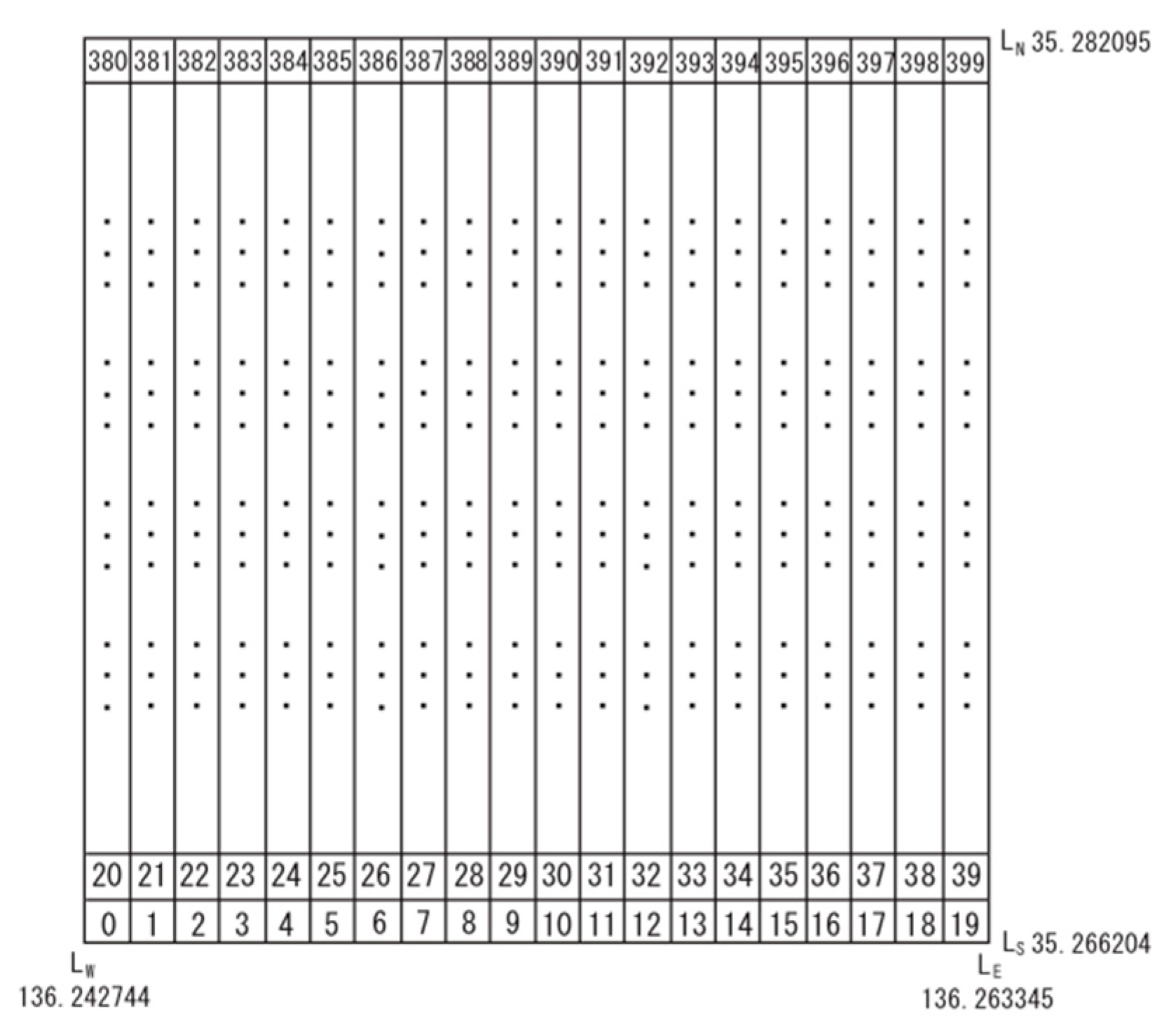
| Sequence on Axes in Figure 9 | Number in Figure A1 and in Axes of Figure 9 | Sequence on Axes in Figure 9 | Number in Figure A1 and in Axes of Figure 9 |
|---|---|---|---|
| 1 | 10 | 44 | 188 |
| 2 | 11 | 45 | 189 |
| 3 | 29 | 46 | 190 |
| 4 | 30 | 47 | 191 |
| 5 | 31 | 48 | 193 |
| 6 | 46 | 49 | 194 |
| 7 | 47 | 50 | 195 |
| 8 | 48 | 51 | 196 |
| 9 | 49 | 52 | 197 |
| 10 | 67 | 53 | 205 |
| 11 | 68 | 54 | 206 |
| 12 | 87 | 55 | 207 |
| 13 | 88 | 56 | 208 |
| 14 | 91 | 57 | 209 |
| 15 | 107 | 58 | 210 |
| 16 | 108 | 59 | 211 |
| 17 | 109 | 60 | 212 |
| 18 | 110 | 61 | 213 |
| 19 | 111 | 62 | 214 |
| 20 | 113 | 63 | 215 |
| 21 | 127 | 64 | 224 |
| 22 | 128 | 65 | 225 |
| 23 | 129 | 66 | 226 |
| 24 | 130 | 67 | 227 |
| 25 | 131 | 68 | 229 |
| 26 | 145 | 69 | 230 |
| 27 | 146 | 70 | 231 |
| 28 | 147 | 71 | 232 |
| 29 | 148 | 72 | 244 |
| 30 | 149 | 73 | 245 |
| 31 | 159 | 74 | 246 |
| 32 | 165 | 75 | 249 |
| 33 | 166 | 76 | 250 |
| 34 | 167 | 77 | 251 |
| 35 | 168 | 78 | 253 |
| 36 | 169 | 79 | 262 |
| 37 | 170 | 80 | 264 |
| 38 | 173 | 81 | 265 |
| 39 | 177 | 82 | 271 |
| 40 | 178 | 83 | 273 |
| 41 | 179 | 84 | 290 |
| 42 | 185 | 85 | 306 |
| 43 | 186 | 86 | 310 |
References
- Brockmann, D.; Hufnagel, L.; Geisel, T. The scaling laws of human travel. Nature 2006, 439, 462–465. [Google Scholar] [CrossRef] [PubMed]
- Gonzalez, M.C.; Hidalgo, C.; Barabasi, A.-L. Understanding individual human mobility patterns. Nature 2008, 453, 779–782. [Google Scholar] [CrossRef] [PubMed]
- Menezes, T.; Roth, C. Natural scales in geographical patterns. Sci. Rep. 2017, 7, 45823. [Google Scholar] [CrossRef]
- Sagarra, O.; Szell, M.; Santi, P.; Diaz-Guilera, A.; Ratti, C. Supersampling and network reconstruction of urban mobility. PLoS ONE 2015, 10, e0134508. [Google Scholar] [CrossRef]
- Taczanowska, K.; Bielanski, M.; Gonzalez, L.-M.; Garcia-Masso, X.; Toca-Herrera, L.L. Analyzing spatial behavior of backcountry skiers in mountain protected areas combining GPS tracking and graph theory. Symmetry 2017, 9, 317. [Google Scholar] [CrossRef]
- Peng, C.; Jin, X.; Wong, K.C.; Shi, M.; Lio, P. Collective human mobility pattern from taxi trips in urban area. PLoS ONE 2012, 7, e34487. [Google Scholar]
- Tachet, R.; Sagarra, O.; Santi, P.; Resta, G.; Szell, M.; Strogatz, S.H.; Ratti, C. Scaling law of urban ride sharing. Sci. Rep. 2017, 7, 42868. [Google Scholar] [CrossRef]
- Cui, Y.; Zhang, M.; Li, J.; Luo, H.; Zhang, X.; Fu, Z. WSMS: Wearable stress konitoring system based on IoT multi-sensor platform for living sheep transportation. Electronics 2019, 8, 441. [Google Scholar] [CrossRef]
- Lucchi, E.; Pereira, L.D.; Andreotti, M.; Malaguti, R.; Cennamo, D.; Calzolari, M.; Frighi, V. Development of a compatible, low cost and high accurate conservation remote sensing technology for the hygrothermal assessment of historic walls. Electronics 2019, 8, 643. [Google Scholar] [CrossRef]
- Hossen, M.I.; Michael, G.K.O.; Connie, T.; Lau, S.H.; Hossain, F. Smartphone-based context flow recognition for outdoor parking system with machine learning approaches. Electronics 2019, 8, 784. [Google Scholar] [CrossRef]
- Blanco-Claraco, J.L.; Mañas-Alvarez, F.; Torres-Moreno, J.L.; Rodriguez, F.; Gimenez-Fernandez, A. Benchmarking particle filter algorithms for efficient velodyne-based vehicle localization. Sensors 2019, 19, 3155. [Google Scholar] [CrossRef]
- Torres, R.; Ohashi, O.; Pessin, G. A machine-learning approach to distinguish passengers and drivers reading while driving. Sensors 2019, 19, 3174. [Google Scholar] [CrossRef]
- Vázquez-Diosdado, J.A.; Paul, V.; Ellis, K.A.; Coates, D.; Loomba, R.; Kaler, J. A combined offline and online algorithm for real-time and long-term classification of sheep behaviour: Novel approach for precision livestock farming. Sensors 2019, 19, 3201. [Google Scholar] [CrossRef]
- Lima, W.S.; Souto, E.; El-Khatib, K.; Jalali, R.; Gama, J. Human activity recognition using inertial sensors in a smartphone: An overview. Sensors 2019, 19, 3213. [Google Scholar] [CrossRef] [PubMed]
- Zhang, J.; Williams, S.; Johnson, H.; Behr, J.; Genrich, J.; Dean, J.; van Domselaar, M.; Agnew, D.; Wyatt, F.; Stark, K.; et al. Southern California permanent GPS geodetic array: Continuous measurements of regional crustal deformation between the 1992 Landers and 1994 Northridge earthquakes. J. Geophys. Res. 1997, 102, 18013–18033. [Google Scholar]
- Gleason, S.; Gebre-egiabher, D. GNSS Applications and Methods; Artech House: Norwood, MA, USA, 2009. [Google Scholar]
- Jin, S.; Feng, G.P.; Gleason, S. Remote sensing using GNSS signals: Current status and future directions. Adv. Space Res. 2011, 47, 1645–1653. [Google Scholar] [CrossRef]
- Choi, W.; Chang, Y.-S.; Jung, Y.; Song, J. Low-power LoRa signal-based outdoor positioning using fingerprint algorithm. ISPRS Int. J. Geo-Inf. 2018, 7, 440. [Google Scholar] [CrossRef]
- Ogudo, K.A.; Nestor, D.M.J.; Khalaf, O.I.; Kasmaei, H.D. A device performance and data analytics concept for smartphones’ IoT services and machine-type communication in cellular networks. Symmetry 2019, 11, 593. [Google Scholar] [CrossRef]
- Tian, H.; Weitnauer, M.A.; Nyengele, G. Optimized gateway placement for interference cancellation in transmit-only LPWA networks. Sensors 2018, 18, 3884. [Google Scholar] [CrossRef]
- Gershenfeld, N.; Krikorian, R.; Cohen, D. The internet of things. Sci. Am. 2004, 291, 76–81. [Google Scholar] [CrossRef]
- Kranz, M.; Holleis, P.; Schmidt, A. Embedded interaction: Interacting with the internet of things. IEEE Internet Comput. 2010, 14, 46–53. [Google Scholar] [CrossRef]
- Atzori, L.; Iera, A.; Morabito, G. The Internet of Things: A Survey. Comput. Netw. 2010, 54, 2787–2805. [Google Scholar] [CrossRef]
- Tokognon, C.J.A.; Gao, B.; Tian, G.Y.; Yan, Y. Structural health monitoring framework based on Internet of Things: A survey. IEEE Internet Things J. 2017, 4, 619–635. [Google Scholar] [CrossRef]
- Statistical Data of Visiting Tourists in Shiga Prefecture in 2018 (Tentative Version). Available online: https://www.pref.shiga.lg.jp/kensei/tokei/syougyou/302905/303923.html (accessed on 21 October 2019). (In Japanese).
- Sen, J. The Sha Fu of Calcutta: The past, the present], and the future of the hand-rickshaw pullers of Calcutta. Is a civilized and progressive transition possible? Bull. Concerned Asian Sch. 1998, 30, 37–49. [Google Scholar] [CrossRef]
- Naomi, W.J. Rickshaw runner. South. Rev. 2007, 43, 326. [Google Scholar]
- Eubank, S.; Guclu, H.; Kumar, V.S.A.; Marathe, M.V.; Srinivasan, A.; Toroczkai, Z.; Wang, N. Modelling disease outbreaks in realistic urban social networks. Nature 2004, 429, 180. [Google Scholar] [CrossRef]
- Miyashita, K. Incremental design of perishable goods markets through multi-agent simulations. Appl. Sci. 2017, 7, 1300. [Google Scholar] [CrossRef]
- Lozano, Á.; De Paz, J.; Villarrubia González, G.; Iglesia, D.; Bajo, J. Multi-agent system for demand prediction and trip visualization in bike sharing systems. Appl. Sci. 2018, 8, 67. [Google Scholar] [CrossRef]
- Mariani, S.; Omicini, A. Special issue “multi-agent systems”: Editorial. Appl. Sci. 2019, 9, 954. [Google Scholar] [CrossRef]
- Julian, V.; Botti, V. Multi-agent systems. Appl. Sci. 2019, 9, 1402. [Google Scholar] [CrossRef]
- Nishikawa, K. The castle town of Hikone and its future. Ekistics 2006, 73, 436–441. [Google Scholar]
- Hokone Travel Guide. Available online: https://visit.hikoneshi.com/en/ (accessed on 21 October 2019).
- Sigfox, a 0G Network. Available online: https://www.sigfox.com/en (accessed on 21 October 2019).
- Hikone Kirakusha Rickshaw. Available online: https://visit.hikoneshi.com/en/plan_your_visit/activities/hikone-kirakusha-rickshaw/ (accessed on 21 October 2019).
- How about “Jinriki-Sha,” Japanese Traditional Taxi by a Self-Running Driver? Available online: https://www.gat-hikone.net/rikisha/index.php (accessed on 21 October 2019).
- Cover, T.M.; Thomas, J.A. Elements of Information Theory, 2nd ed.; John Wiley & Sons: Hoboken, NJ, USA, 2006; pp. 52–59. [Google Scholar]
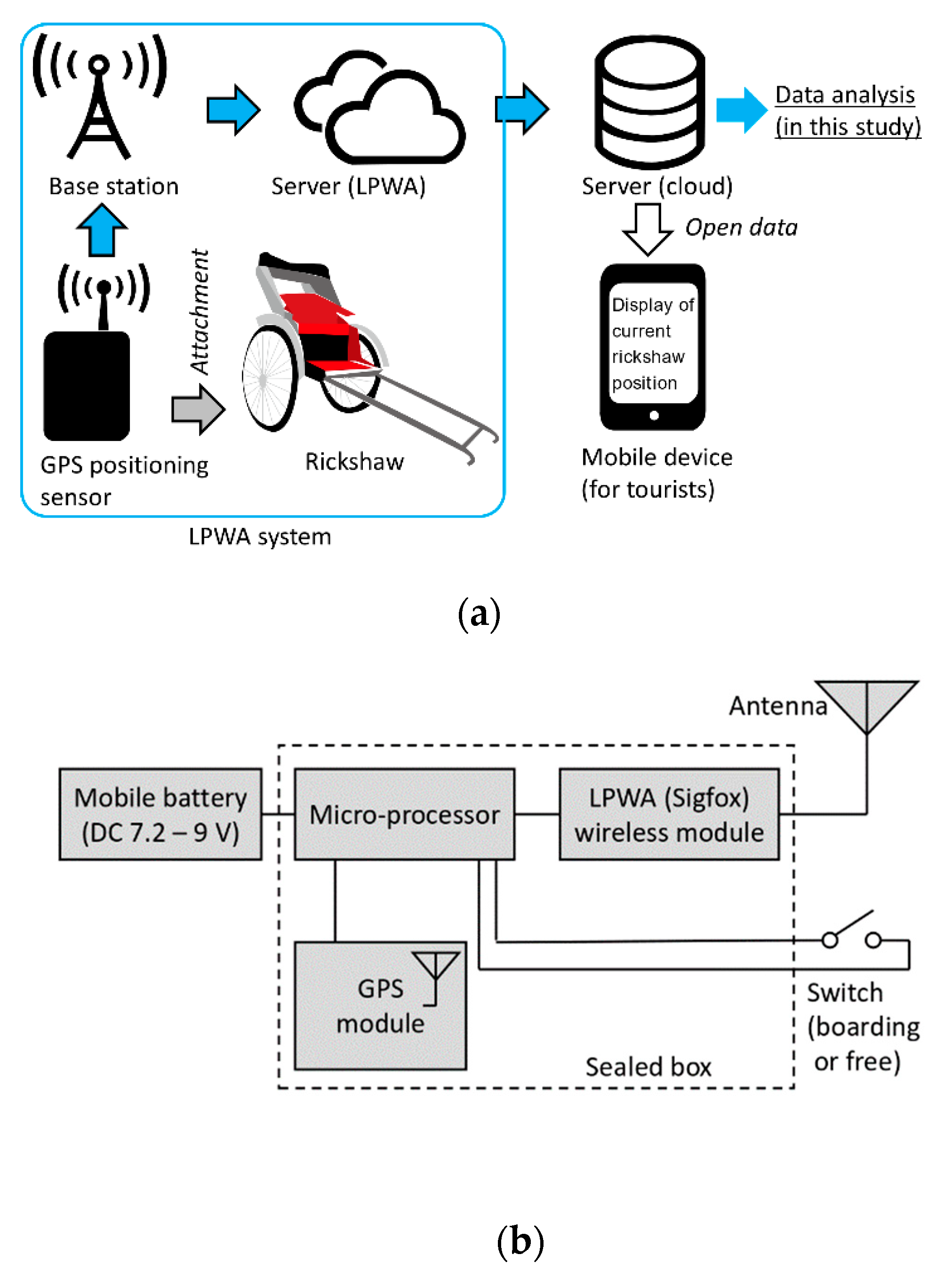
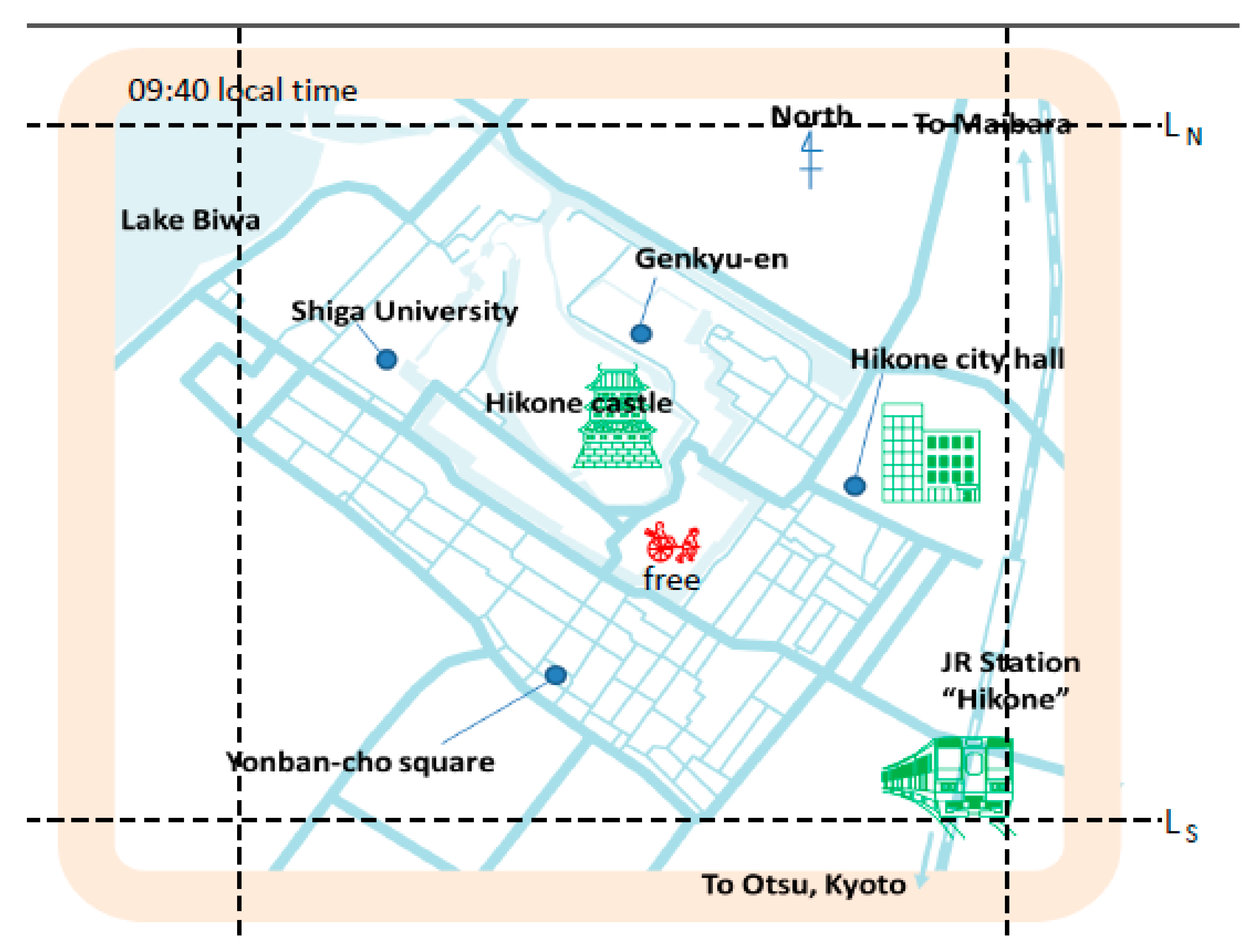
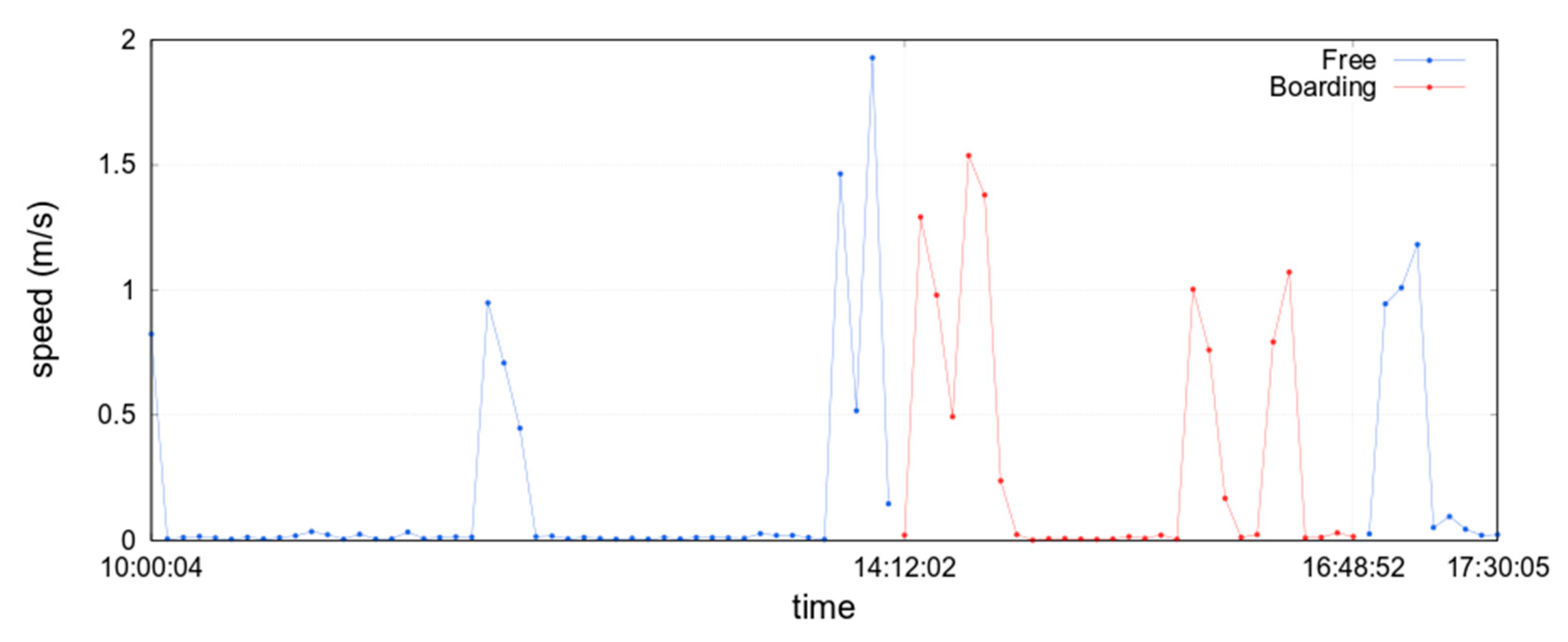
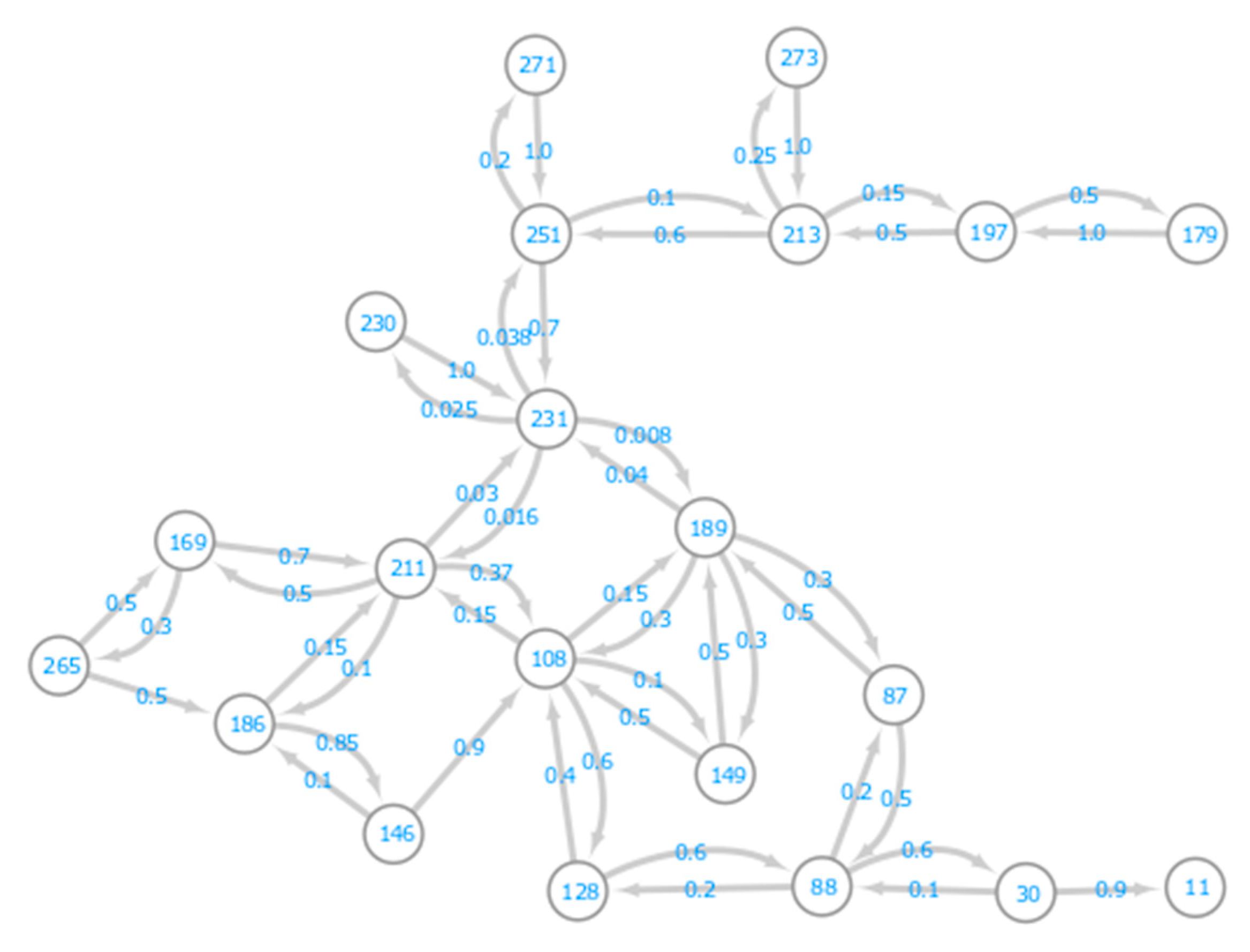
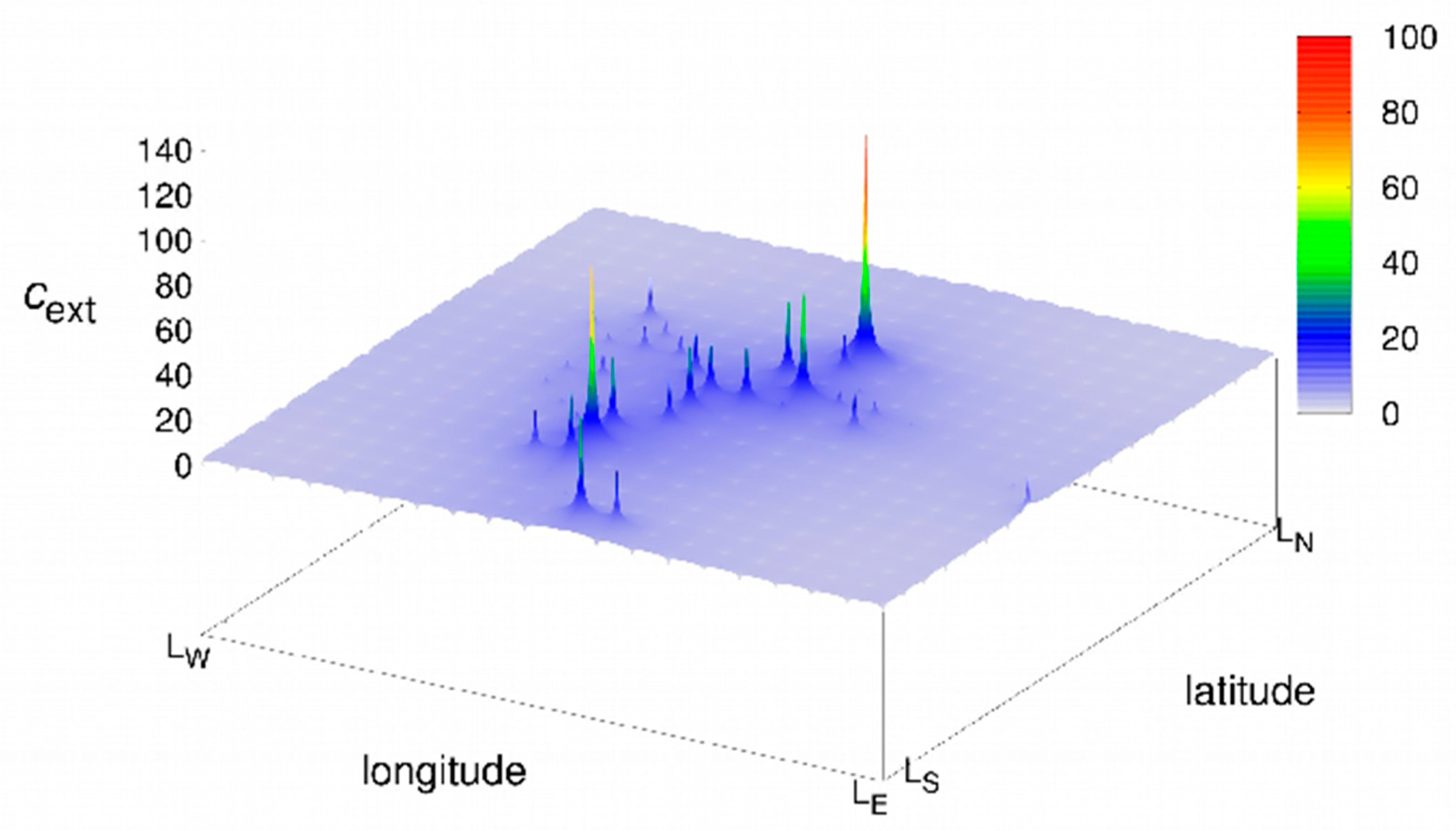
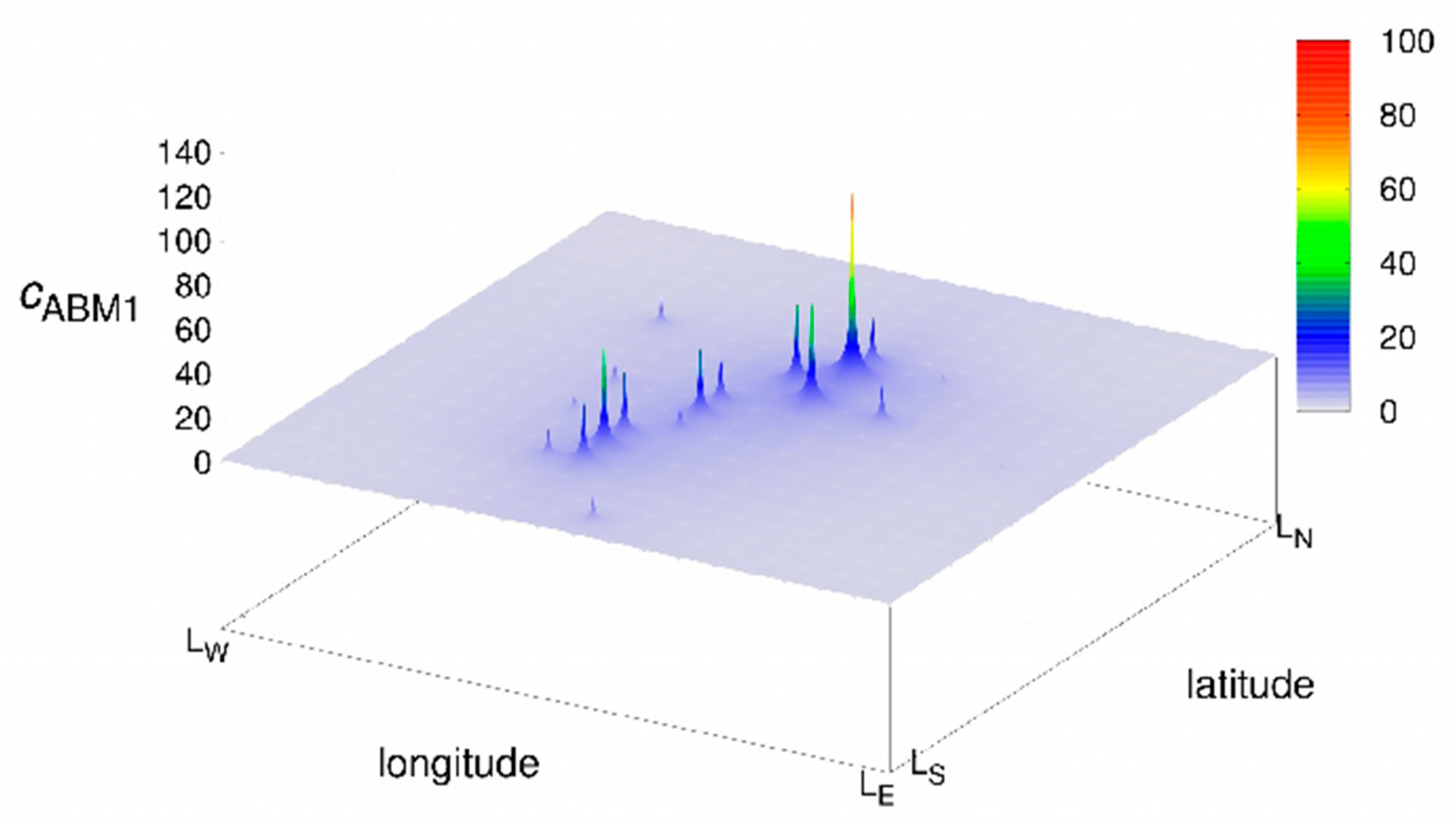
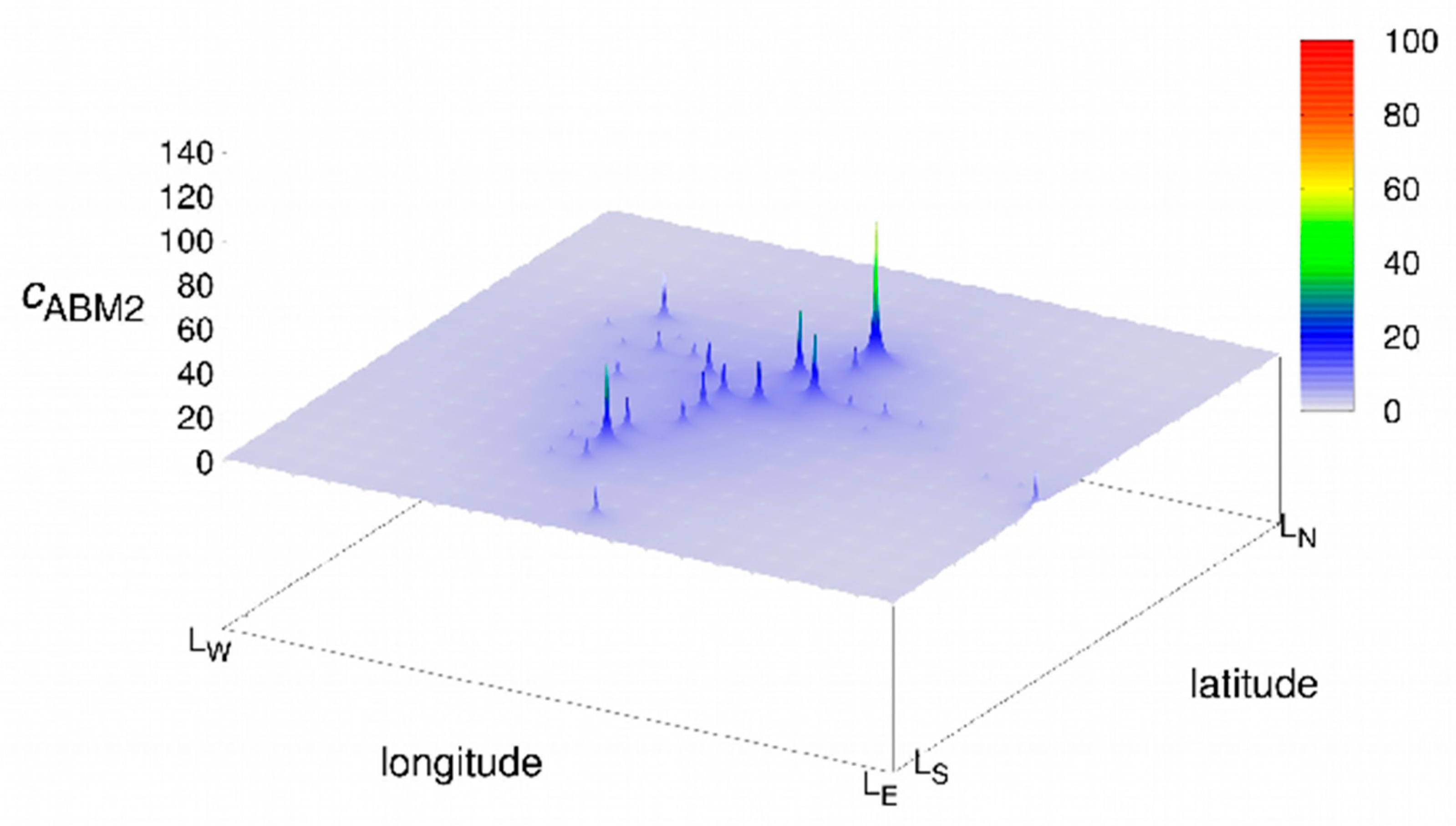
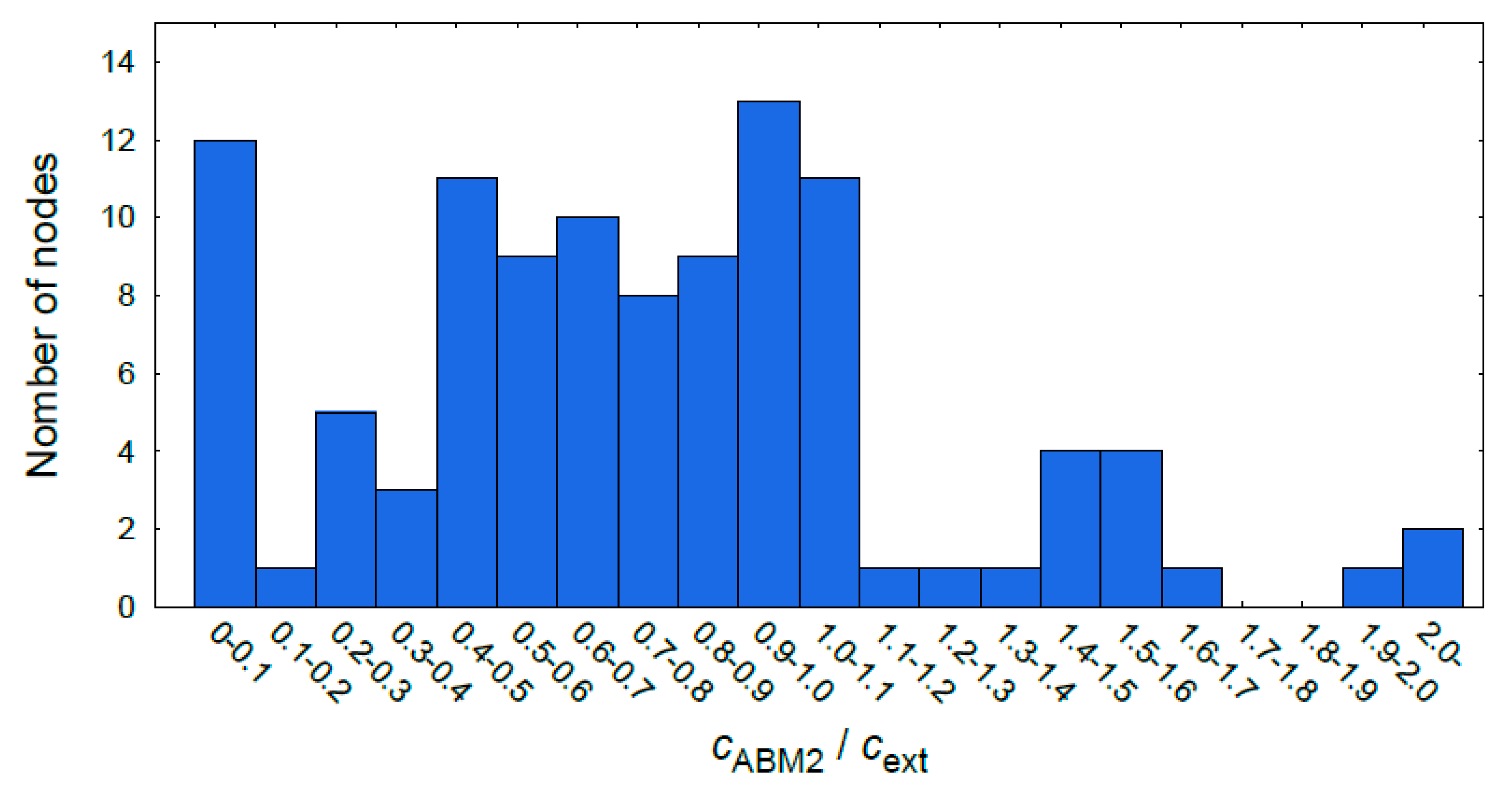
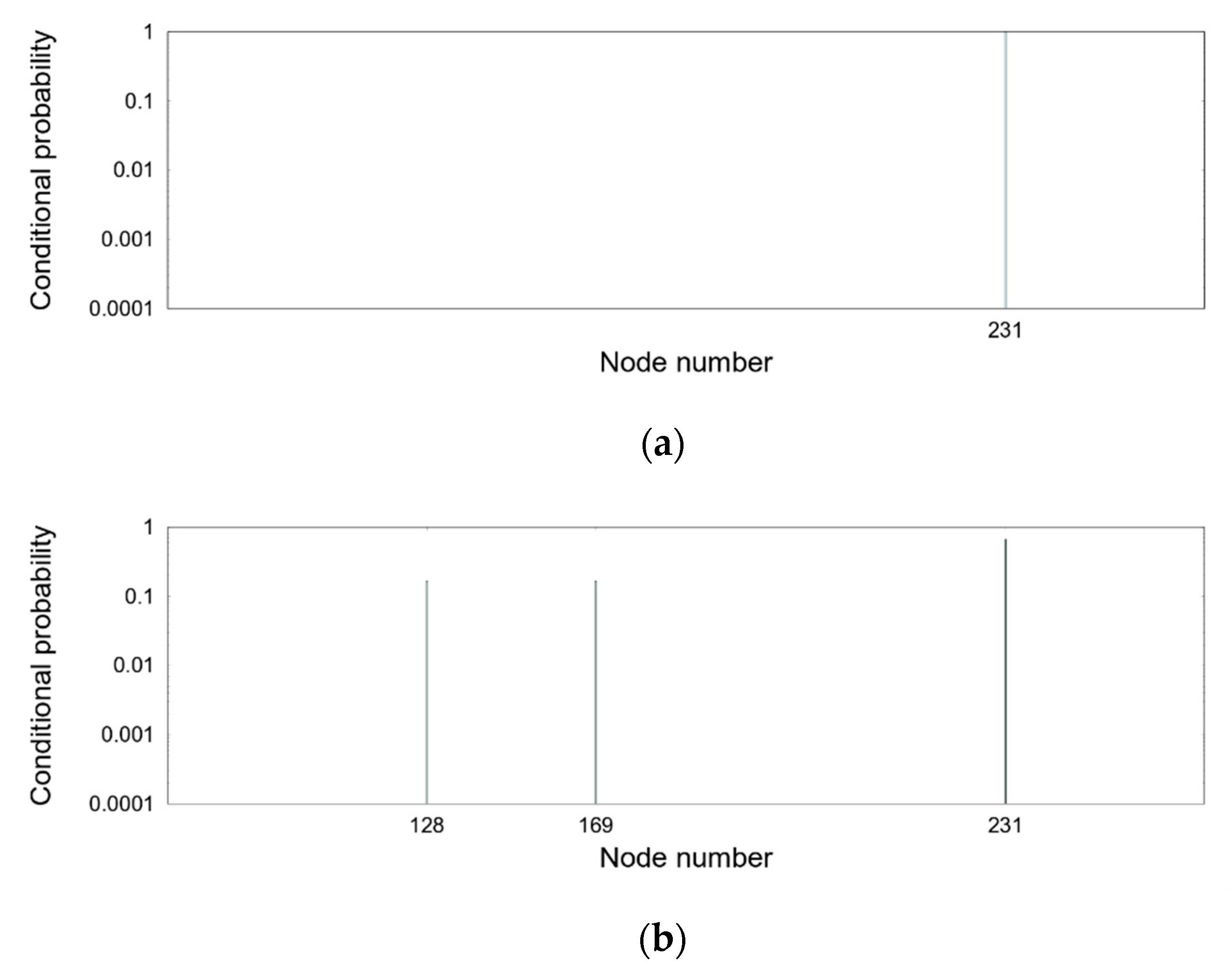
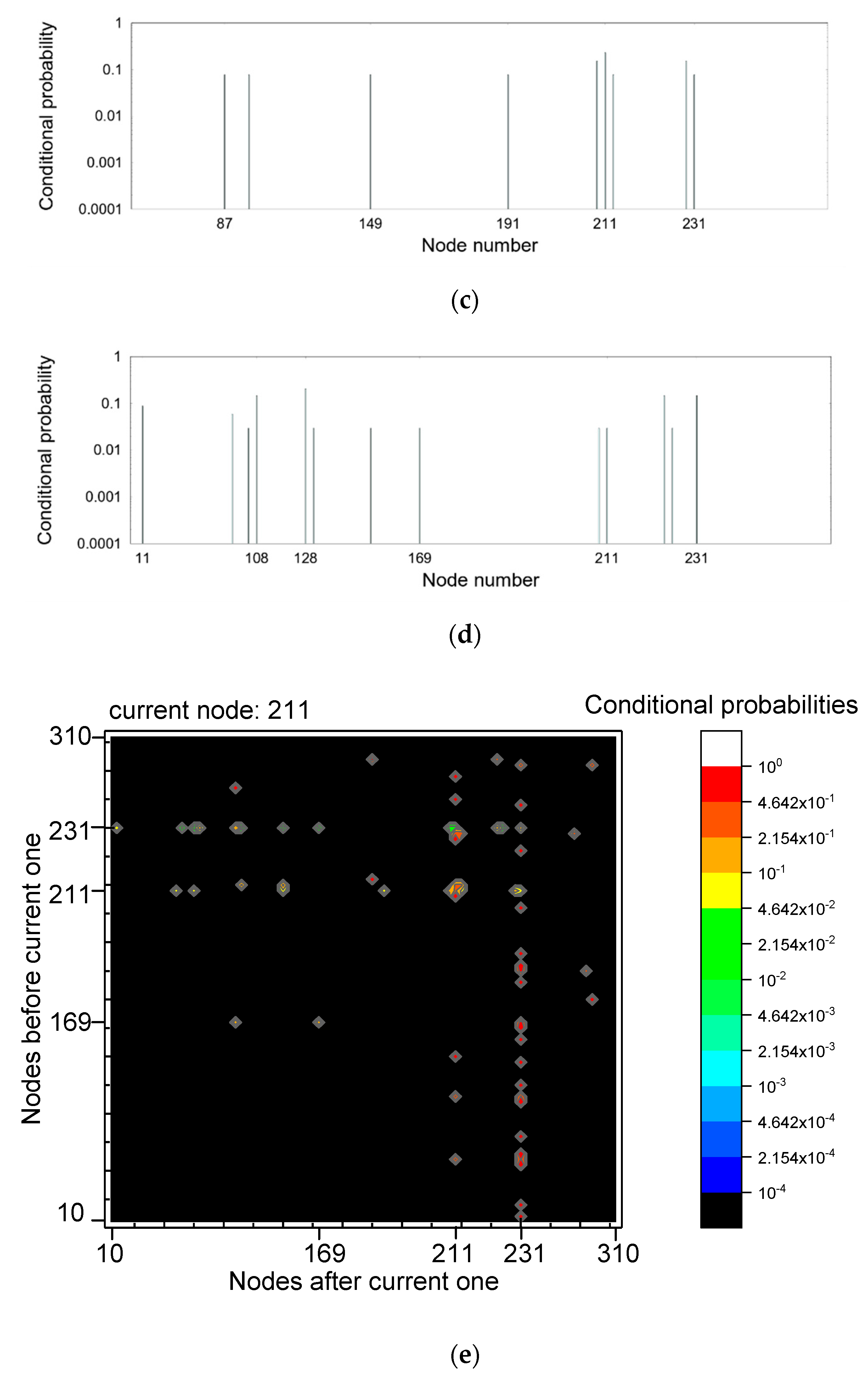
| Device 1 | Time | Latitude | Longitude | Node # | Passenger |
|---|---|---|---|---|---|
| 741D82 | 16:00:05 on 9 May 2019 | 35.272357 | 136.252577 | 149 | Y |
| 741D82 | 16:05:04 on 9 May 2019 | 35.272905 | 136.250573 | 167 | Y |
| 741D82 | 16:10:04 on 9 May 2019 | 35.272558 | 136.250197 | 147 | Y |
| 741D82 | 16:15:04 on 9 May 2019 | 35.272575 | 136.250168 | 167 | Y |
| 741D82 | 16:20:05 on 9 May 2019 | 35.272557 | 136.250228 | 147 | Y |
| 741D82 | 16:25:05 on 9 May 2019 | 35.272105 | 136.252340 | 149 | Y |
| 741D82 | 16:30:05 on 9 May 2019 | 35.272092 | 136.254260 | 231 | Y |
| 741D82 | 16:35:04 on 9 May 2019 | 35.275110 | 136.254282 | 231 | Y |
| 741D82 | 16:40:05 on 9 May 2019 | 35.275143 | 136.254302 | 231 | Y |
| 741D82 | 16:45:05 on 9 May 2019 | 35.275102 | 136.254227 | 231 | Y |
| 741D82 | 16:48:52 on 9 May 2019 | 35.275095 | 136.254198 | 231 | N |
| 741D82 | 16:50:05 on 9 May 2019 | 35.275085 | 136.254213 | 231 | N |
| 741D82 | 16:55:05 on 9 May 2019 | 35.272402 | 136.252560 | 149 | N |
| 741D82 | 17:00:05 on 9 May 2019 | 35.268890 | 136.251577 | 68 | N |
| 741D82 | 17:05:05 on 9 May 2019 | 35.266640 | 136.254318 | 11 | N |
| 741D82 | 17:10:04 on 9 May 2019 | 35.266535 | 136.254432 | 11 | N |
| 741D82 | 17:15:05 on 9 May 2019 | 35.266890 | 136.254400 | 11 | N |
| 741D82 | 17:20:05 on 9 May 2019 | 35.266762 | 136.254475 | 11 | N |
| 741D82 | 17:25:05 on 9 May 2019 | 35.266733 | 136.254525 | 11 | N |
| 741D82 | 17:30:05 on 9 May 2019 | 35.266713 | 136.254465 | 11 | N |
© 2020 by the authors. Licensee MDPI, Basel, Switzerland. This article is an open access article distributed under the terms and conditions of the Creative Commons Attribution (CC BY) license (http://creativecommons.org/licenses/by/4.0/).
Share and Cite
Yamamoto, K.; Yoshida, J.; Miyagi, S.; Minami, S.; Minami, D.; Sakai, O. Mobilities in Network Topology and Simulation Reproducibility of Sightseeing Vehicle Detected by Low-Power Wide-Area Positioning System. Electronics 2020, 9, 116. https://doi.org/10.3390/electronics9010116
Yamamoto K, Yoshida J, Miyagi S, Minami S, Minami D, Sakai O. Mobilities in Network Topology and Simulation Reproducibility of Sightseeing Vehicle Detected by Low-Power Wide-Area Positioning System. Electronics. 2020; 9(1):116. https://doi.org/10.3390/electronics9010116
Chicago/Turabian StyleYamamoto, Keigo, Jun Yoshida, Shigeyuki Miyagi, Shinsuke Minami, Daisuke Minami, and Osamu Sakai. 2020. "Mobilities in Network Topology and Simulation Reproducibility of Sightseeing Vehicle Detected by Low-Power Wide-Area Positioning System" Electronics 9, no. 1: 116. https://doi.org/10.3390/electronics9010116
APA StyleYamamoto, K., Yoshida, J., Miyagi, S., Minami, S., Minami, D., & Sakai, O. (2020). Mobilities in Network Topology and Simulation Reproducibility of Sightseeing Vehicle Detected by Low-Power Wide-Area Positioning System. Electronics, 9(1), 116. https://doi.org/10.3390/electronics9010116






